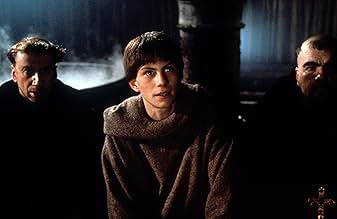An intellectually nonconformist friar investigates a series of mysterious deaths in an isolated abbey.An intellectually nonconformist friar investigates a series of mysterious deaths in an isolated abbey.An intellectually nonconformist friar investigates a series of mysterious deaths in an isolated abbey.
- Won 2 BAFTA Awards
- 17 wins & 6 nominations total
Donald O'Brien
- Pietro d'Assisi
- (as Donal O'Brian)
Storyline
Did you know
- TriviaSean Connery's career was at such a low point when he read for the role that Columbia Pictures refused to finance the movie when Jean-Jacques Annaud cast him as William von Baskerville.
- GoofsThe secret message on the parchment is exposed three times. The translator heated it to reveal the location of the library, William of Baskerville heated it again when he was in the scriptorium and yet again to show the others the message. When a message is written in lemon juice, heating it will cause it to become exposed because the sugar in the juice is caramelized and thus would not disappear again.
- Quotes
William of Baskerville: But what is so alarming about laughter?
Jorge de Burgos: Laughter kills fear, and without fear there can be no faith, because without fear of the Devil there is no more need of God.
- Crazy creditsThe opening credits read - A palimpsest of Umberto Eco's Novel The Name of the Rose
- Alternate versionsCertain prints of the movie have the sex scene between Adso and The Girl removed in order to comply with local laws.
Featured review
A number of people have commented on the similarity of this film, and the Novel by Umberto Eco, to the DaVinci Code. For those who were not born then, The Name of the Rose was published in 1980, thus predating DaVinci by about 20 or more years. I must admit that I found DaVinci to be a mass market popularization of Eco's theme, in short a "rip off". Still, it may be the popularity of Brown's novel which has resulted in Name of the Rose being brought back in a DVD version, and for that I am truly thankful.
For a film which was not favorably reviewed by the critics, it is surprising how many reviewers 20 years later are giving it a 10. Either the film wore well or tastes have changed. I loved the film first time around and was delighted to find it on DVD. Certainly the screenplay had to deviate from the philosophizing of the book. It would have been almost unwatchably "talkie" had it not, and those of us who want to read the sermons/discussions can read the book. The film stands on it's own.
The most ominous feeling for me, living in the religious and politically free thinking 21st century, was the realization that the church had such a grip on every aspect of life and thinking in the middle ages, and that any perceived repudiation of accepted Church dogma was deemed heresy and punishable by torture and a horrible death. That one group of people should wield such power, and the length they would go to to hold on to that power is truly frightening. The rigid class structure where the nobility and church owned the land which the peasants worked, and supported those above them while being kept down by those above, was very well conveyed in the film. Life was short and hard, health was poor and the plague could return at any time, carrying off those who had not been carried off by the incessant wars. Not a pleasant age to live. The period of the film is set just prior to the reformation. It is hardly surprising that the teachings of the various religious orders began to be questioned.
For a film which was not favorably reviewed by the critics, it is surprising how many reviewers 20 years later are giving it a 10. Either the film wore well or tastes have changed. I loved the film first time around and was delighted to find it on DVD. Certainly the screenplay had to deviate from the philosophizing of the book. It would have been almost unwatchably "talkie" had it not, and those of us who want to read the sermons/discussions can read the book. The film stands on it's own.
The most ominous feeling for me, living in the religious and politically free thinking 21st century, was the realization that the church had such a grip on every aspect of life and thinking in the middle ages, and that any perceived repudiation of accepted Church dogma was deemed heresy and punishable by torture and a horrible death. That one group of people should wield such power, and the length they would go to to hold on to that power is truly frightening. The rigid class structure where the nobility and church owned the land which the peasants worked, and supported those above them while being kept down by those above, was very well conveyed in the film. Life was short and hard, health was poor and the plague could return at any time, carrying off those who had not been carried off by the incessant wars. Not a pleasant age to live. The period of the film is set just prior to the reformation. It is hardly surprising that the teachings of the various religious orders began to be questioned.
Details
- Release date
- Countries of origin
- Languages
- Also known as
- Ime rože
- Filming locations
- Kloster Eberbach, Eltville Am Rhein, Hessen, Germany(interiors: monastery church)
- Production companies
- See more company credits at IMDbPro
Box office
- Budget
- ITL 30,000,000,000 (estimated)
- Gross US & Canada
- $7,153,487
- Opening weekend US & Canada
- $494,571
- Sep 28, 1986
- Gross worldwide
- $7,153,487
- Runtime2 hours 10 minutes
- Color
- Aspect ratio
- 1.85 : 1
Contribute to this page
Suggest an edit or add missing content


























